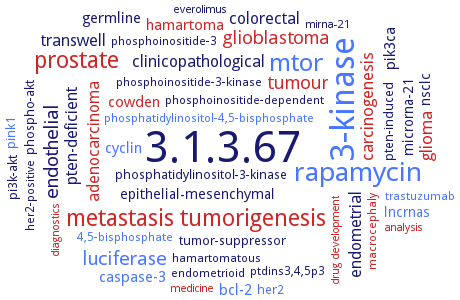3.1.3.67: phosphatidylinositol-3,4,5-trisphosphate 3-phosphatase
This is an abbreviated version!
For detailed information about phosphatidylinositol-3,4,5-trisphosphate 3-phosphatase, go to the full flat file.

Word Map on EC 3.1.3.67 
-
3.1.3.67
-
3-kinase
-
rapamycin
-
mtor
-
tumorigenesis
-
prostate
-
metastasis
-
endothelial
-
luciferase
-
glioblastoma
-
tumour
-
glioma
-
carcinogenesis
-
endometrial
-
clinicopathological
-
pten-deficient
-
adenocarcinoma
-
colorectal
-
transwell
-
hamartoma
-
cowden
-
caspase-3
-
bcl-2
-
germline
-
cyclin
-
pik3ca
-
epithelial-mesenchymal
-
lncrnas
-
nsclc
-
microrna-21
-
phosphatidylinositol-3-kinase
-
tumor-suppressor
-
pten-induced
-
her2
-
phospho-akt
-
pink1
-
pi3k-akt
-
4,5-bisphosphate
-
macrocephaly
-
her2-positive
-
hamartomatous
-
endometrioid
-
ptdins3,4,5p3
-
phosphatidylinositol-4,5-bisphosphate
-
phosphoinositide-3-kinase
-
phosphoinositide-dependent
-
trastuzumab
-
phosphoinositide-3
-
analysis
-
drug development
-
everolimus
-
diagnostics
-
medicine
-
mirna-21
- 3.1.3.67
- 3-kinase
- rapamycin
- mtor
- tumorigenesis
- prostate
- metastasis
- endothelial
- luciferase
- glioblastoma
- tumour
- glioma
- carcinogenesis
- endometrial
-
clinicopathological
-
pten-deficient
- adenocarcinoma
- colorectal
-
transwell
- hamartoma
- cowden
- caspase-3
- bcl-2
-
germline
- cyclin
- pik3ca
-
epithelial-mesenchymal
- lncrnas
-
nsclc
-
microrna-21
-
phosphatidylinositol-3-kinase
-
tumor-suppressor
-
pten-induced
- her2
-
phospho-akt
- pink1
-
pi3k-akt
- 4,5-bisphosphate
- macrocephaly
-
her2-positive
-
hamartomatous
-
endometrioid
-
ptdins3,4,5p3
- phosphatidylinositol-4,5-bisphosphate
- phosphoinositide-3-kinase
-
phosphoinositide-dependent
- trastuzumab
-
phosphoinositide-3
- analysis
- drug development
-
everolimus
- diagnostics
- medicine
-
mirna-21
Reaction
Synonyms
1-phosphatidylinositol-3,4,5-trisphosphate 3-phosphohydrolase, MMAC1/TEP1, phosphatase and tensin homolog, phosphatase and tensin homologue, phosphatase and tensin homologue deleted on chromosome 10, phosphatidylinositol 3,4,5-trisphosphate-specific phosphatase, phosphatidylinositol-3,4,5-trisphosphate 3-phosphatase, PI 3-phosphatase, PTEN, PTEN phosphatase, PTEN/MMAC, PTEN/MMAC1, SidF, TPIP, tumor suppressor PREN, voltage-sensing phosphatase, Voltage-sensing phosphoinositide phosphatase, VSP


 results (
results ( results (
results ( top
top






